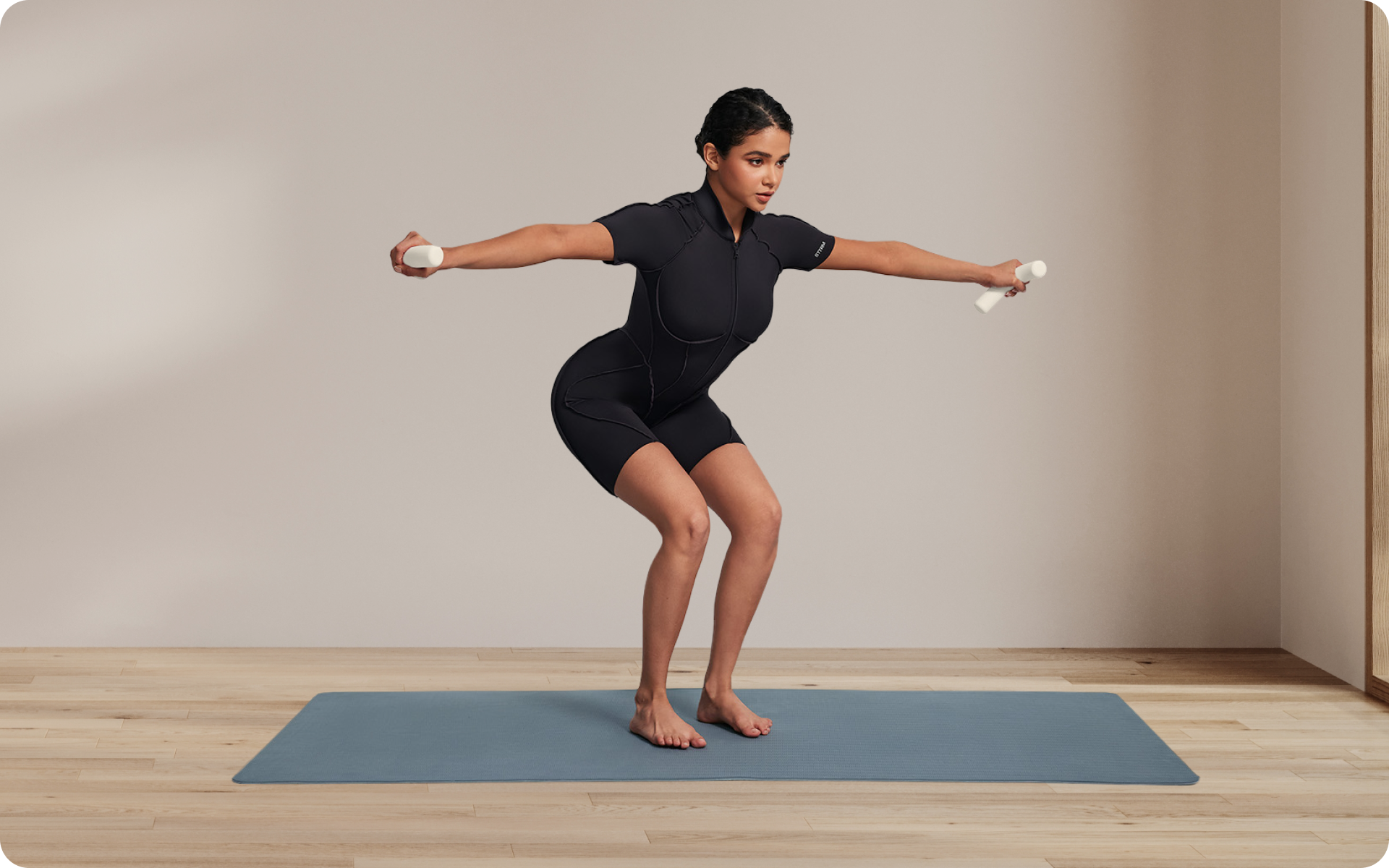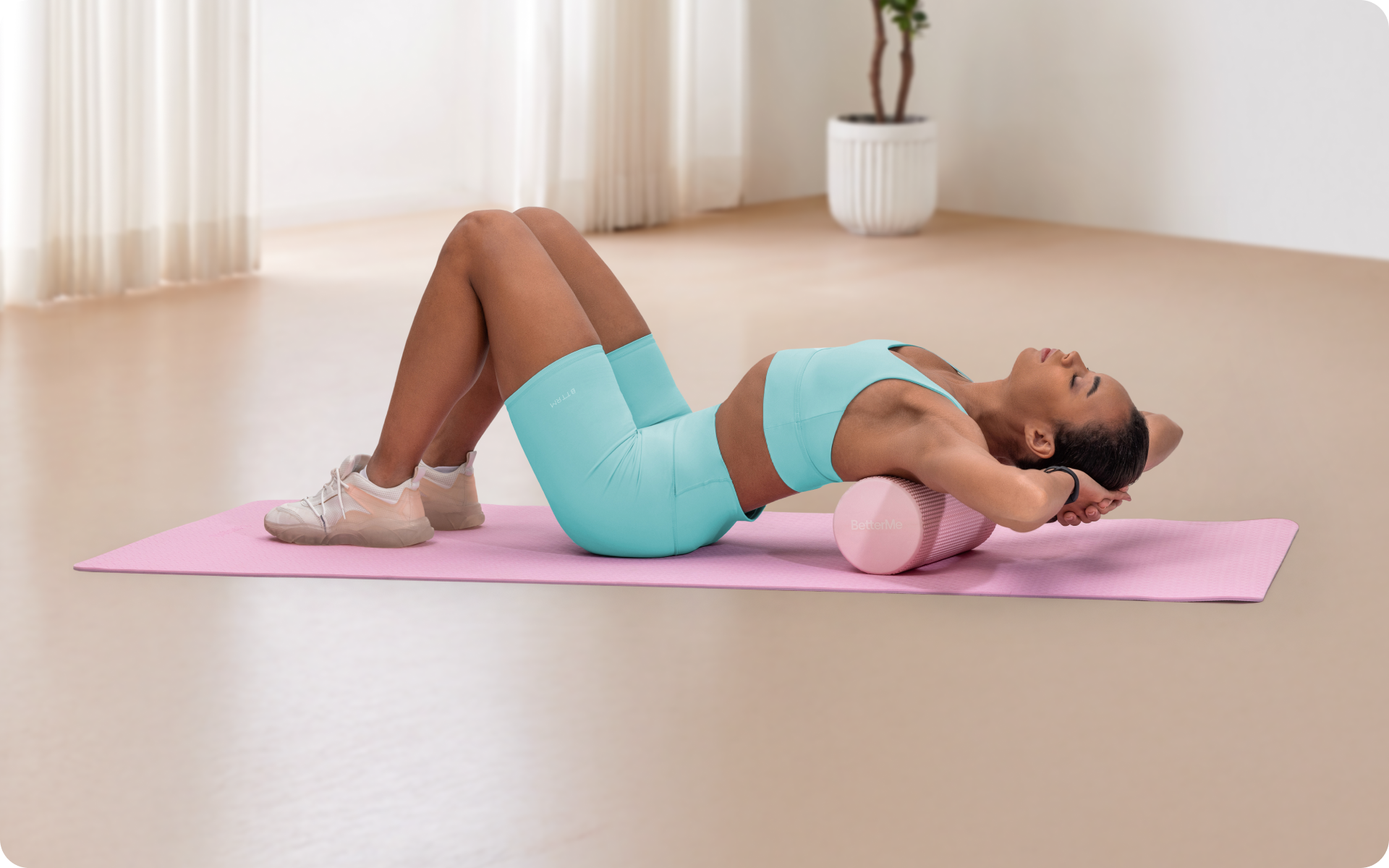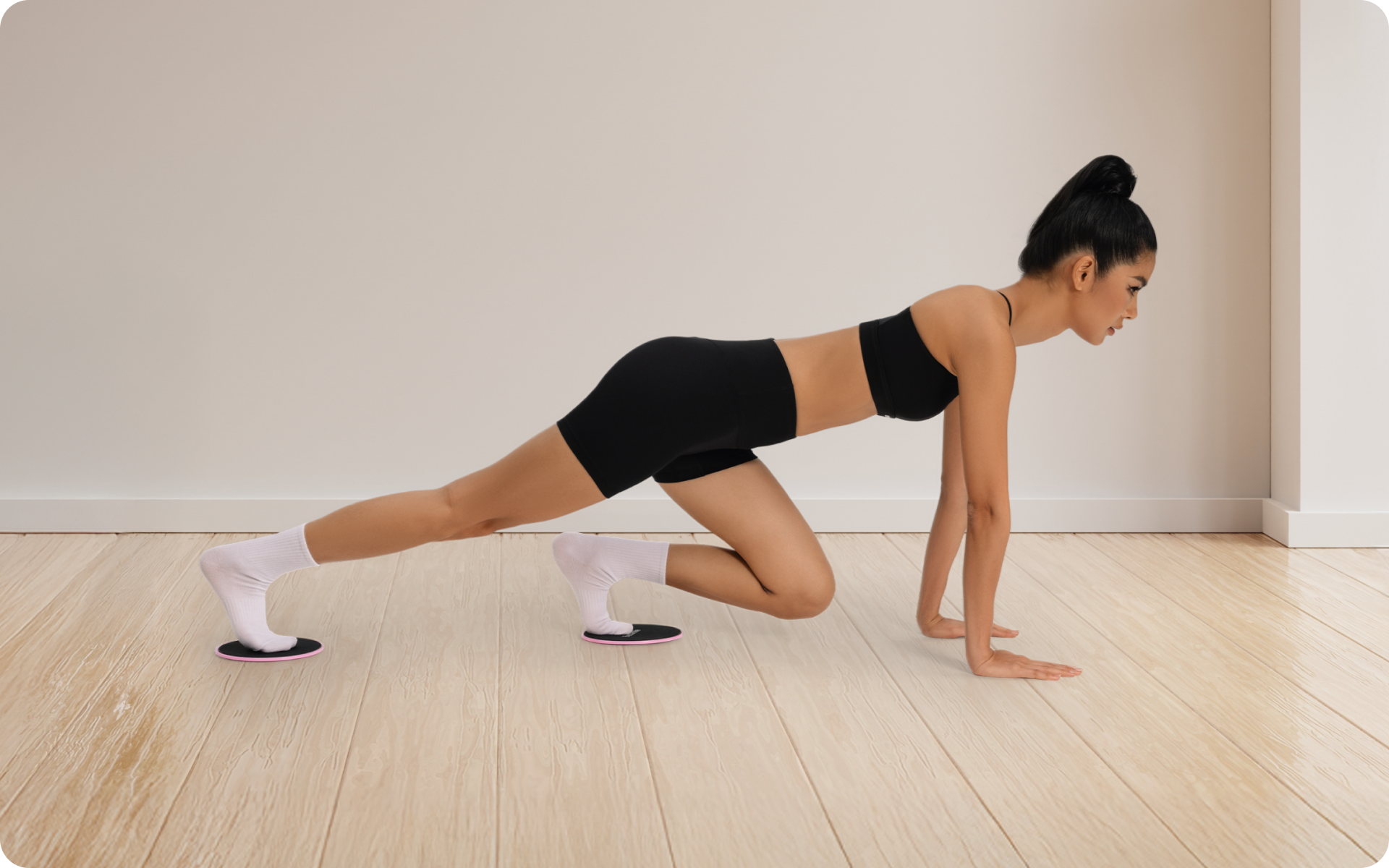A flat stomach is not just about aesthetics; it’s also an indicator of good health. Research shows that visceral fat – the type stored deep in your abdomen – is particularly harmful, increasing your risk for diabetes, heart disease, and even certain types of cancer (1.)
In fact, it’s possible to be thin but still harbor dangerous levels of this ‘hidden’ fat. And if you’re carrying extra weight around your middle, it’s likely that visceral fat is playing a part.
That said, losing belly fat isn’t just a vanity project – it’s a crucial part of improving your health.
The exercises in this guide are designed to target your core, helping to strengthen your abdominal muscles and burn belly fat. They incorporate both high-intensity cardio and strength training, proven strategies for fat loss and muscle building.
How Can I Flatten My Stomach Fast?
The best, and most effective way to flatten your stomach is by combining regular exercise with a healthy diet.
Let’s be clear – the goal isn’t a “flat” stomach, because a completely flat stomach is neither healthy nor achievable for most people.
What we’re aiming for is to burn belly fat, while strengthening the core. Reducing body fat percentage has the added bonus of revealing more defined abs, and strengthening the core muscles can result in better posture and stability (5).
Lean and toned up body isn’t just a far-fetched fantasy. Check out the BetterMe app and watch it propel your weight loss journey into high gear!
7 Easy Exercises for a Flat Stomach and Small Waist
These exercises to flatten stomach work for females and males, simply because they target overall body fat loss and toning. For beginners, most of these flat stomach exercises can be simplified by performing the versions with bent knees.
High-Intensity Jump Rope Circuit
Research into how High-Intensity Interval Training (HIIT) compares to other forms of exercise in regards to burning fat reveal that, unsurprisingly, HIIT is one of the best workouts for losing weight (8).
That’s because it combines intense bursts of activity with short recovery periods, which have been shown to boost metabolism and burn fat both during and after workouts.
The jump rope is an excellent choice for a high-intensity cardio workout that also targets the abdominal muscles. In fact, it’s considered one of the best exercises for burning belly fat as it engages all major muscle groups in the body, including the core, arms, and legs.
Here’s a simple HIIT jump rope circuit you can try:
- 30 seconds of high-intensity jump rope
- 10 seconds rest
- 30 seconds of mountain climbers
- 10 seconds rest
- Repeat for a total of 3 rounds.
Note: You can increase the duration or number of rounds as you progress and get stronger.
Plank Variations
The plank is a simple yet effective exercise for strengthening the core and toning the abdominal muscles. Here are three variations to try:
- Standard Plank – Begin in a push-up position, with your arms extended and hands directly under your shoulders. Hold for 30 seconds to start, working up to one minute.
- Side Plank – Start in a standard plank position, then rotate your body to the side, supporting yourself on one arm and one foot on the edge. You can also perform this from your knees. Hold for 15-30 seconds to start, gradually increasing the duration over time.
- Plank Jacks – Begin in a standard plank position, then jump both feet out wide like you’re doing a jumping jack. Jump them back together and repeat for 30 seconds to start, working up to one minute.
Russian Twists
This exercise targets the obliques which are the muscles on the sides of your abdomen. Here’s how to do it:
- Sit on the floor with your knees bent and feet flat on the ground.
- Lean back slightly and lift your feet a few inches off the ground, and engage your core to maintain your balance.
- Keep your arms straight out in front of you, then twist your torso to the right side, tapping the floor with your hands.
- Twist back to center, then repeat on the left side. This is one rep.
- Continue alternating sides for 30 seconds to start, working up to one minute.
Read more: Ultimate Abs And Butt Workout For Flat Stomach And Bigger Butt
Mountain Climbers
This exercise targets the entire core, while also providing a great cardio workout. Here’s how to do it:
- Start in a push-up position with your arms extended and hands directly under your shoulders.
- Bring your right knee towards your chest, then quickly switch legs, bringing your left knee towards your chest as you extend your right leg back.
- Continue alternating legs for 30 seconds to start, working up to one minute.
Reverse Crunches
This exercise targets the lower abdominal muscles. Here’s how to do it:
- Lie on your back with your arms at your sides and palms facing down.
- Bend your knees and lift your feet off the ground until they’re parallel with your hips.
- Slowly raise your knees towards your chest, lifting your hips off the ground. Hold for a second, then slowly lower back down to starting position.
- Repeat for 30 seconds to start, working up to one minute.
Bicycle Crunches
This exercise targets both the upper and lower abdominal muscles, while also engaging the obliques. Here’s how to do it:
- Lie on your back with your hands behind your head and elbows pointing out.
- Bring your right elbow towards your left knee while straightening your right leg.
- Switch sides, bringing your left elbow towards your right knee while extending the left leg.
- Continue alternating for 30 seconds to start, working up to one minute.
Leg Raises
This exercise targets the lower abdominal muscles. Here’s how to do it:
- Lie on your back with your arms at your sides and palms facing down.
- Keeping your legs straight, slowly lift them off the ground until they’re perpendicular to the floor.
- Hold for a second, then slowly lower back down to starting position.
- Repeat for 15-30 seconds to start, working up to one minute or adding more sets.
Looking for a way to break the vicious cycle of weight loss and tone up all the jiggly parts? Watch the extra pounds fly off and your muscles firm up with the BetterMe app!
High-Intensity Resistance Training
Incorporating resistance training into your workout routine is crucial for building muscle and burning fat (13). Here are a few exercises to add:
- Squats – Stand with your feet shoulder-width apart, then squat down until your thighs are parallel with the floor. Push back up through your whole foot and repeat.
- Lunges – Step forward or backwards with one leg, lowering your body until both knees are bent at a 90-degree angle. Push back up through your front heel and repeat on the other side.
- Deadlifts – Hold a barbell or dumbbells in front of you with an overhand grip. Bend at the hips and lower the weight towards the ground, keeping the weights close to your body and your back straight. Push back up through your heels and repeat.
- Push-Ups – Start in a plank position with your hands directly under your shoulders. Lower yourself down until your chest touches the ground, then push back up to starting position.
The reps, sets, and rest periods for resistance training that burns fat are as follows:
- Aim for 3 sets of 8-12 reps for each exercise.
- Rest for 60-90s seconds between sets.
- For best results, incorporate these exercises into your HIIT circuit by performing them during the recovery periods. This will keep your heart rate elevated and maximize fat-burning potential.
- Don’t forget to also include rest days in your workout routine to allow your muscles time to recover and grow stronger.
Read more: Types of Stomach Fat: Which One is Hindering Your Health?
How to Eat Less to Flatten Your Stomach?
Even with the best exercises to flatten stomach at home, your diet also plays a crucial role in achieving a flat stomach. Here are some tips how to eat less and reducing belly fat:
- Eat slowly – It takes about 20 minutes for your brain to register that you’re full, so eat slowly and stop when you feel satisfied rather than stuffed.
- Focus on nutrient-dense foods that are rich in fiber – These foods can be more filling and nutritious, making it easier to eat less (10).
- Drink plenty of water – Sometimes we mistake thirst for hunger, so stay hydrated to avoid unnecessary snacking.
- Don’t skip meals – Skipping meals can lead to overeating later on in the day.
- Eat protein-rich foods – Protein-rich foods can help you feel full for longer (11), making it easier to control your calorie intake.
- Limit intake of added sugars and refined carbohydrates – These types of foods eaten in excess, can cause bloating and contribute to weight gain (2).
- Practice portion control – Use smaller plates and measure out servings to avoid overeating (14).
Essentially, the tips above are to help you maintain a calorie deficit (burning more calories than you consume) in order to lose belly fat and reveal those toned abs (7).
How much of a deficit you should aim for depends on individual factors such as age, height, weight, and activity level.
There are many online calculators and apps that can help you determine your maintenance level and calorie deficit goals.
In our guide – How to Make Your Stomach Flat Overnight, we discuss food choices that may cause bloating, and how to reduce bloating quickly.
FAQs
Why Can’t I Lose Belly Fat?
You may be struggling to lose fat because;
- You’re not in a calorie deficit – As mentioned earlier, you need to burn more calories than you consume in order to lose fat.
- Your hormones may be imbalanced – Hormones such as cortisol and insulin can affect fat storage and weight loss (6). Consult a doctor if you suspect hormonal imbalances.
- You’re not getting enough quality sleep – Lack of sleep can disrupt hormones that regulate appetite and lead to weight gain (12).
Your stress levels are high – Stress can cause elevated cortisol levels and may contribute to stubborn belly fat or weight gain (3). Find healthy ways to manage stress such as exercise or mindfulness techniques.
Does Walking Burn Belly Fat?
Walking is a great form of low-impact exercise that can contribute to overall weight loss and fat burning, including in the abdominal area (4).
To get the most out of your walks, aim for at least 30 minutes of brisk walking daily and try to incorporate some hills or inclines to increase the intensity.
What Are 3 Easy Exercises To Lose Belly Fat?
High-intensity interval training, or HIIT, can be a highly effective way to target belly fat and overall weight loss (8). Any exercise that gets your heart rate up and challenges your muscles can be incorporated into a HIIT workout.
Two other exercises that work well for targeting belly fat low intensity steady state cardio, such as running or cycling, and full-body strength training that incorporates abdominal strengthening exercises.
Remember that spot reduction is not possible – fat loss will occur throughout your body with consistent exercise and a healthy diet.
Can I Slim My Stomach In a Week?
Yes, you can slim your stomach in a week if you’re dealing with bloating or excess water weight. This can be achieved by reducing your salt intake and increasing your water intake, as well as incorporating the tips mentioned earlier for eating less and reducing bloating.
However, losing actual fat in a week is not realistic or sustainable. Consistent effort and healthy habits are required for long-term fat loss and a flat stomach.
The Bottom Line
A flat stomach isn’t just about looking good – it’s also important for overall health and reducing the risk of chronic diseases. By incorporating resistance training, HIIT, and a healthy diet, you can effectively burn fat and reveal those toned abs.
DISCLAIMER:
This article is intended for general informational purposes only and does not serve to address individual circumstances. It is not a substitute for professional advice or help and should not be relied on for making any kind of decision-making. Any action taken as a direct or indirect result of the information in this article is entirely at your own risk and is your sole responsibility.
BetterMe, its content staff, and its medical advisors accept no responsibility for inaccuracies, errors, misstatements, inconsistencies, or omissions and specifically disclaim any liability, loss or risk, personal, professional or otherwise, which may be incurred as a consequence, directly or indirectly, of the use and/or application of any content.
You should always seek the advice of your physician or other qualified health provider with any questions you may have regarding a medical condition or your specific situation. Never disregard professional medical advice or delay seeking it because of BetterMe content. If you suspect or think you may have a medical emergency, call your doctor.
SOURCES
- A critical review of methods for visceral adipose tissue analysis (2018, birpublications.org)
- Association between changes in carbohydrate intake and long term weight changes: prospective cohort study (2023, ncbi.nlm.nih.gov)
- Cortisol, obesity and the metabolic syndrome: A cross-sectional study of obese subjects and review of the literature (2013, ncbi.nlm.nih.gov)
- Effect of walking exercise on abdominal fat, insulin resistance and serum cytokines in obese women (2014, ncbi.nlm.nih.gov)
- Effects of core strength training on core stability (2018, ncbi.nlm.nih.gov)
- Endocrine disorders associated with obesity (2023, sciencedirect.com)
- Fat loss depends on energy deficit only, independently of the method for weight loss (2007, pubmed.ncbi.nlm.nih.gov)
- High-Intensity Intermittent Exercise and Fat Loss (2011, hindawi.com)
- Increasing muscle mass to improve metabolism (2023, ncbi.nlm.nih.gov)
- Optimising foods for satiety (2015, sciencedirect.com)
- Protein, weight management, and satiety (2008, sciencedirect.com)
- Sleep Deprivation: Effects on Weight Loss and Weight Loss Maintenance (2022, mdpi.com)
- Strength training: Get stronger, leaner, healthier (2023, mayoclinic.org)
- Understanding the science of portion control and the art of downsizing (2019, ncbi.nlm.nih.gov)









